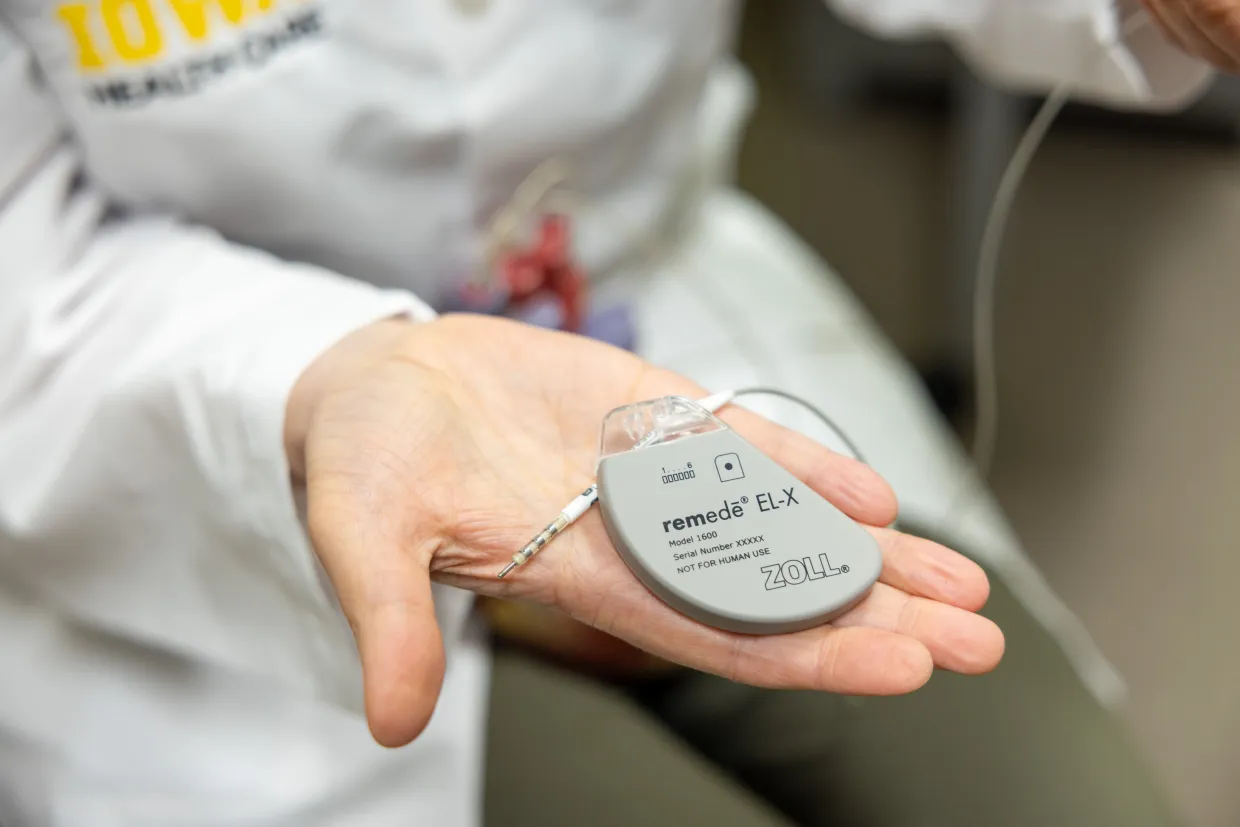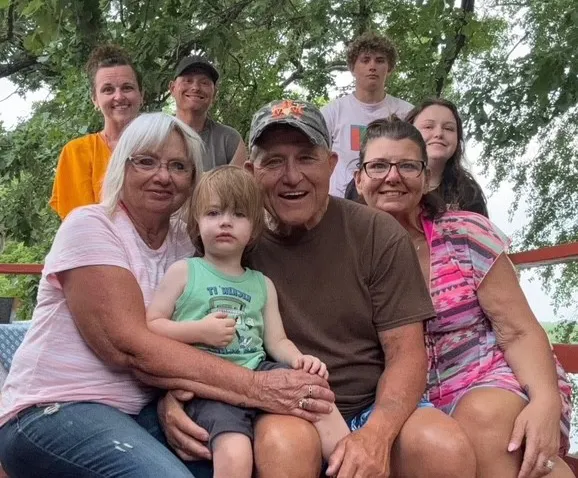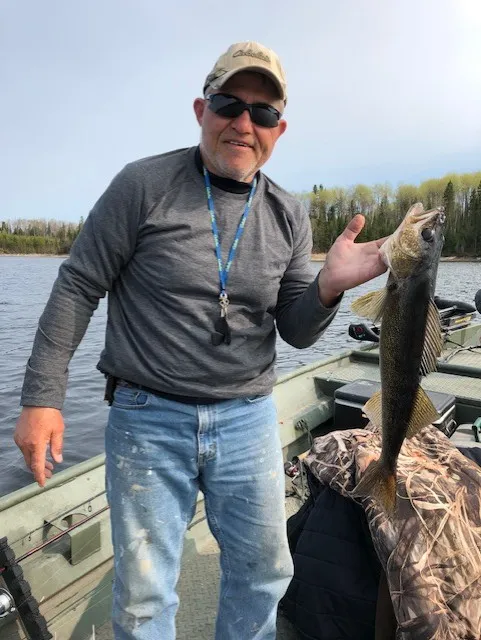Breathing easy: A patient’s experience with the Remede® System
Ken Mulholland, a lifelong athlete, didn’t know he had central sleep apnea until his family noticed he was gasping in his sleep. Unwilling to use a CPAP machine, he turned to UI Health Care and found a life-changing solution in the Remede® System.

Recognizing the signs of central sleep apnea at home
Ken Mulholland of Savanna, Illinois, built his life around health and discipline. A longtime powerlifter, marathon runner, international dragon boat racer, and former personal trainer, he spent decades pushing himself physically and inspiring others.
“I always kept myself in better than average shape,” Mulholland says.
But even athletes in peak condition can overlook hidden health risks. For years, Mulholland had no idea he was living with central sleep apnea. He felt fine. He stayed active. But at night, his wife noticed something troubling.
“My wife said, ‘Honey, you stop breathing at night and you start gasping,’" he says.
Mulholland responded with disbelief and humor.
“I used to joke, ‘I stayed awake all night, never stopped breathing once,’” he says.
It wasn’t until a series of family members raised concerns—including his brother and granddaughter—that he agreed to get tested. What his granddaughter said stuck with him:
“She said to me, ‘Grandpa, you stop breathing. If you ever want to see your great-grandson grow up, you better get something done.’ And that is what generated my interest,” he says.
Diagnosing central sleep apnea: A surprising discovery
Mulholland underwent a sleep study and was diagnosed with central sleep apnea. It was a shock.
“I was in denial,” he says. “I’m 75 years old right now; mind-wise, I still think I’m 55. But my body is telling me different.”
Despite the diagnosis, Mulholland knew what he wouldn’t do: wear a CPAP (continuous positive airway pressure) machine. This device delivers a steady flow of air through a mask worn over your mouth and nose while you sleep.
“There is no way that I’m going to use a CPAP machine,” he reflects. “I would not and could not put that on my face and go to sleep. I knew that ahead of time.”
Instead, his physician in Freeport, IL referred him to UI Health Care for an alternative: the Remede® System. This surgically implanted device treats central sleep apnea by helping the body restore a natural breathing rhythm.
What is the Remede® System for central sleep apnea?
“The Remede® System is basically a pacemaker that is placed in a vein that is situated right next to the left phrenic nerve,” explains Paari Dominic, MBBS, MPH, the cardiac electrophysiologist who treated Mulholland.
The device delivers continuous stimulation throughout the night at a set rate—similar to how a pacemaker regulates heart rhythm. This stimulation helps maintain a steady breathing pattern while the patient sleeps.
Unlike CPAP, the system is completely internal and activates only during a set sleep window, and only when the patient is lying on their back.
“CPAP can be pretty claustrophobic for some people,” Dominic says. The Remede® System avoids any external equipment. It is a minimally invasive therapy that does require a surgical procedure for implantation.
Personalized sleep apnea treatment at UI Health Care
Once he arrived at UI Health Care, Mulholland began to feel comfortable.
“My mind was set at ease after talking to the doctor and all the people I’ve had contact with at Iowa,” he says. “Everyone has been amazing—absolutely from start to finish. Every one of them has just been so professional, friendly, and so in tune to my needs and concern for my well-being.”
The device isn’t activated immediately. It takes four to six weeks to learn a patient’s sleep pattern. Then, over several visits, it is adjusted to meet their needs.
Mulholland returned for additional programming and adjustments until the system functioned optimally.
“Now it’s absolutely perfect. I sleep well. It doesn’t wake me,” he says. “I go back to bed and fall right back to sleep. My wife says there’s absolutely no gasping and no stopping of breathing whatsoever.”
Valerie Hinschberger, PA-C, a physician assistant for UI Health Care’s neurology team, referred Mulholland and says he's a great example of how this treatment can improve a patient's quality of life.
“It's been rewarding working with Ken. He has been patient with the team as we have made adjustments to the device to get it functioning optimally for him,” she says.
Life after Remede®: Improved sleep and energy
Mulholland no longer naps during the day. He rises at 5 a.m. without an alarm and stays active with walking, light lifting, and outdoor work.
“I would say my energy level is great,” he says. “We go up in the woods and cut wood and mow lawns and work around the house.”
Though his training days are behind him, Mulholland credits the Remede® System with helping him maintain his quality of life.
“I definitely want to be around long enough to see my great-grandson grow up,” he says.


Mulholland’s story is far from unusual, according to Dominic. Many people with central sleep apnea don’t experience obvious symptoms—or don’t realize the symptoms they do have are related to their breathing during sleep.
Dominic says the daylight symptoms can be very mild.
“They can have episodes where they feel like they're more tired, like they want to take a nap in the afternoon.”
Mulholland notes that he often felt this way.
Dominic adds that these warning signs often go unrecognized. That’s why, he says, the role of family or close observers is vital.
How Remede® helps patients with sleep apnea and heart failure
Dominic notes that the Remede® System can also benefit patients with heart conditions.
“Central sleep apnea can be a cause or an effect of heart failure,” he says. “Remede® has been shown in studies to actually improve heart failure and heart failure symptoms. So, especially for patients who have both sleep apnea and heart failure, this is an awesome solution.”
UI Health Care is one of the top Remede® implanters in the country.
Mulholland says his decision to seek care at UI Health Care is based on long-standing trust and strong reputation.
“I’ve always had a real high regard for the University of Iowa,” he says.
Today, he sleeps soundly—and breathes easier—knowing he made the right call.